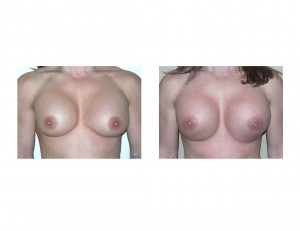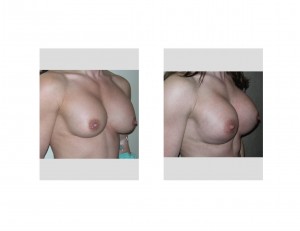Background: Breast augmentation can be done placing implants either above or below the pectoralis major muscle. There are arguments for and against either implant location although the vast majority of plastic surgeons today opt for an under the muscle (subpectoral) implant position. The reasons are better tissue coverage of the implant and a reduced risk of long-term capsular contracture. Another advantage is that they can look more natural with a more gradual upper pole shape.
But in the small number of women who seek breast augmentation that are body builders, the concern about disruption of pectoral muscle shape and function is an understandable one. This is why historically most breast implants in female body builders were done above the muscle. (subglandular position) While this ensures no risk of muscle dysfunction, they usually appear anything but natural. The implant shape is often easily discernible due to the low body fat and breast tissue content of this type of athletic body
When breast implants are placed under the muscle, there are essentially two techniques. A complete submuscular position means that all of the breast implant is covered by muscle. This can make the implant appear too high and is only effective if the implant volume is small and the lower breast fold to muscle border are at the same or near the same levels. A partial or dual-plane submuscular position is where only part of the implant is under the muscle, anywhere from half to two-thirds of it. This avoids having an implant position that is too high as many patients have a lower border of the pectoralis muscle that is at or will end up higher than the existing or new level of the inframammary fold.
Case Study: This 36 year-old female was an amateur body builder that had saline breast implants placed three years previously. There were already in a submuscular position that appeared to be completely under the muscle. She now desired larger and fuller breasts and a switch to silicone implants. Her existing breast implants were 300cc.


As this female bodybuilder illustrates, she had no problem with subpectoral breast implant placement with either her first or second set of implants. Whether it is a total submuscular or a dual-plane position, breast implants do not adversely affect function and development of the pectoralis muscle.
Case Highlights:
1) Breast augmentation can be successfully done in female body builders.
2) Breast implants placed under the pectoralis muscle can look natural.
3) Subpectoral breast augmentation does not cause a significant weakening of pectoralis muscle function or development.
Dr. Barry Eppley
Indianapolis, Indiana


